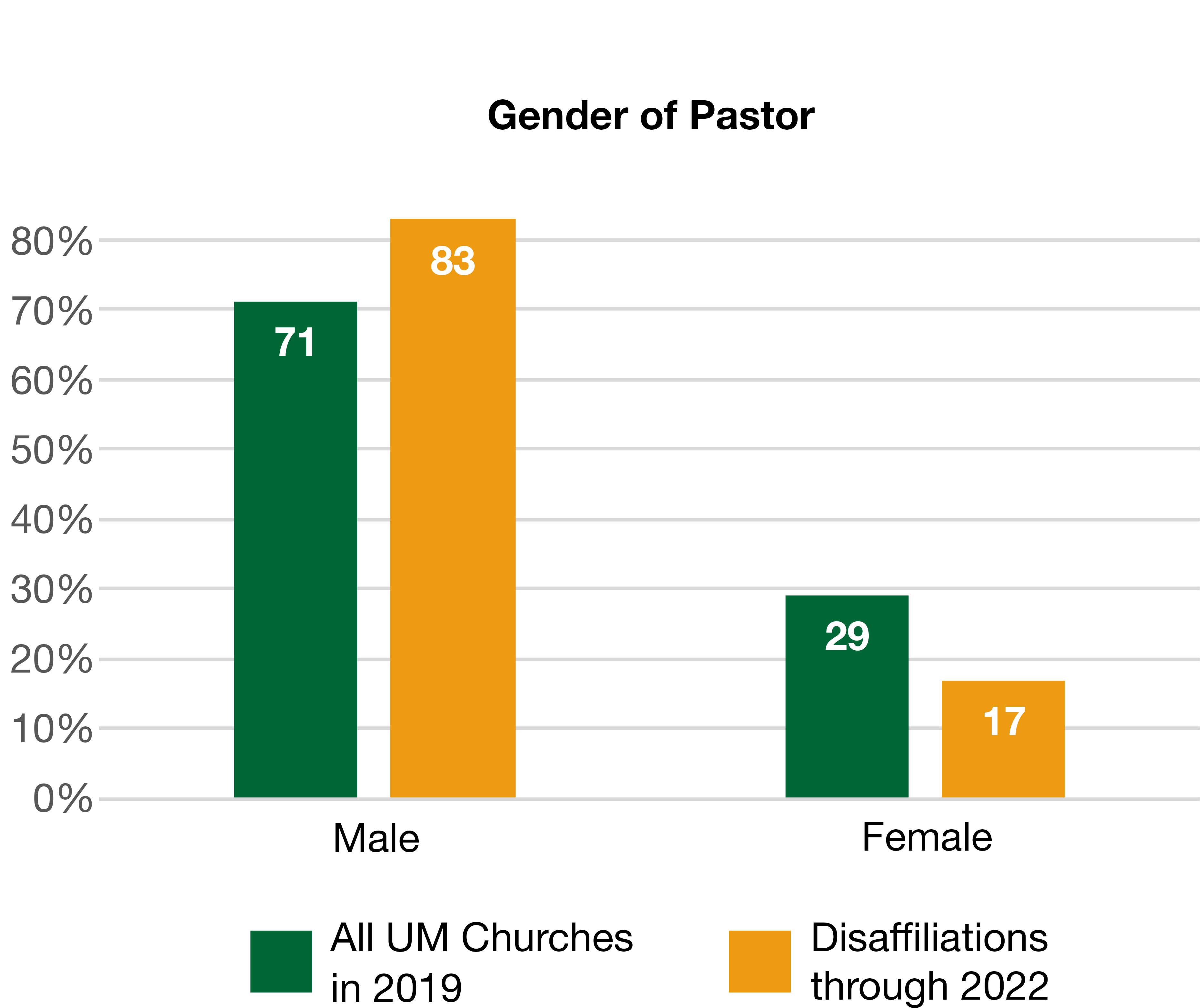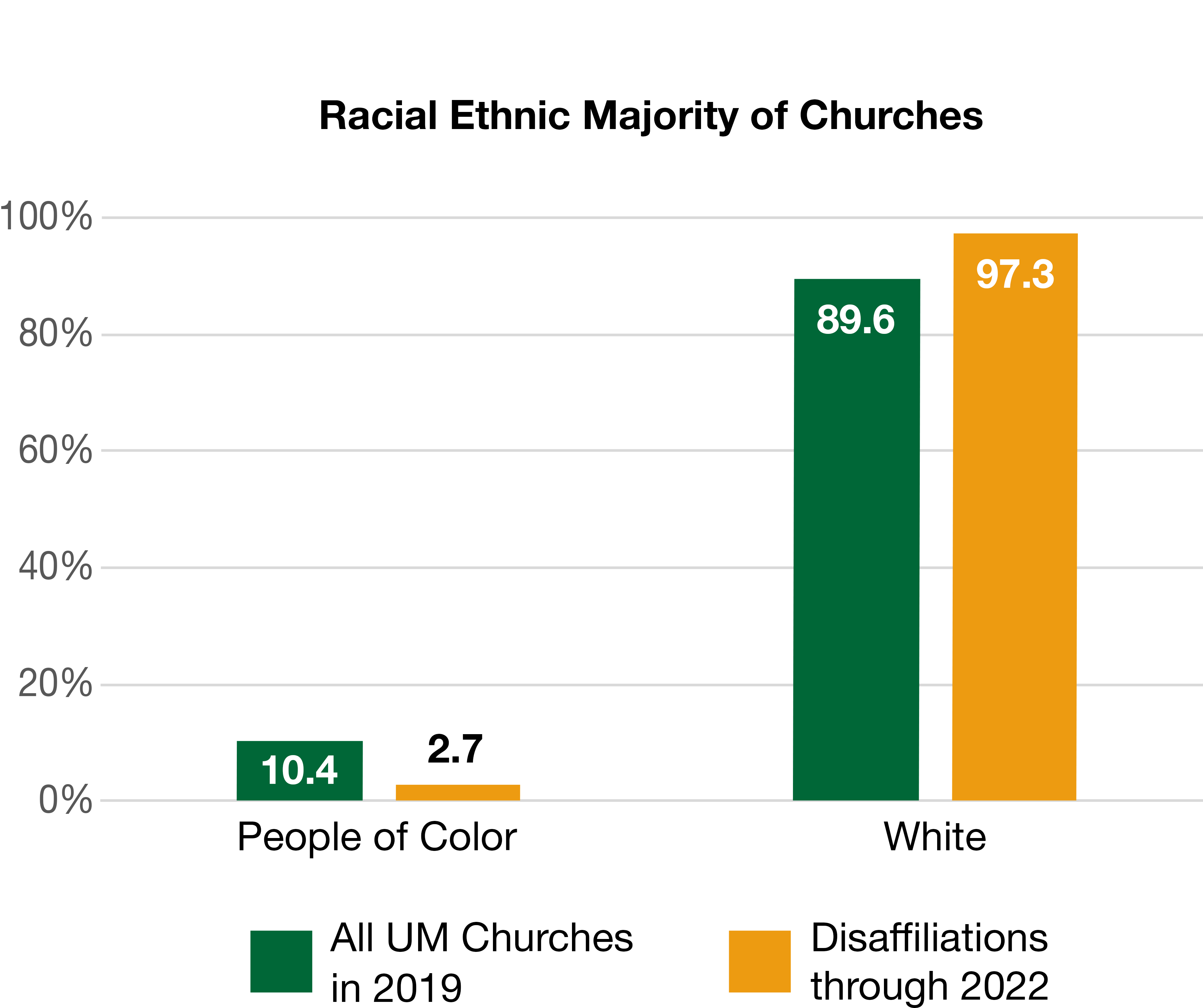The shape of the current and future United Methodist Church took on clearer lines after events in the past month, topped by results from an analysis of the characteristics of departing churches.
Disaffiliation developments included nine decisions and a memorandum from the UMC’s top church court about departures, along with a surprising agreement by the Council of Bishops regarding the exit process outside the United States. In addition, the president of the bishops’ council gave an unprecedented address on the “state of the church,” urging United Methodists to move from “rancor to revival.”
The Lewis Church Leadership Center at UMC-related Wesley Theological Seminary in Washington, D.C., released results from a study of the 1,800 churches that have disaffiliated from the 12-million-member worldwide denomination since 2019. Led by an eminent United Methodist scholar, Lovett H. Weems Jr., the study found most of the churches leaving the UMC are located in the U.S. South and Southeast.
The UMC’s South Central and Southeastern jurisdictions comprise 52% of United Methodist churches and 84% of disaffiliations.
 The region covers roughly the same states in which the former Methodist Episcopal Church, South was active from 1850 to 1939. The ME, South Church (as it is known colloquially) formed after the Methodist Church split over slavery in 1844.
The region covers roughly the same states in which the former Methodist Episcopal Church, South was active from 1850 to 1939. The ME, South Church (as it is known colloquially) formed after the Methodist Church split over slavery in 1844.
In addition to sharing a cultural and church history, the Lewis Center analysis found most disaffiliating churches are likely to have a white, male pastor and to be a predominantly white congregation.
“Many persons have been asking about a systematic comparison since most United Methodist clergy and laity do not have a good picture of the profile of disaffiliating churches and, just as importantly, of those churches not disaffiliating,” the report says.
According to a UM News report by Sam Hodges, “The Lewis Center report draws on data from the denomination’s General Council on Finance and Administration, as well as other church sources. The report looks at churches approved for disaffiliation through the end of 2022, and identified 1,967, amounting to 6.6% of total U.S. churches in 2019.”
As of March 1, a BNG review found 2,036 congregations have completed the requirements to leave the UMC.
Thomas Bickerton, president of the United Methodist Council of Bishops, said he believes the Lewis Center report is as valuable for what it tells about congregations that are staying as for those that are leaving.
“We have to work hard to refashion our message around ministry and mission, and this study helps to clarify that,” said Bickerton, who leads the New York Annual (regional) Conference.
Local churches must get the approval of their annual conferences to leave the denomination with their property, since all property is held “in trust” for the denomination. Conference approval is part of the process stipulated in Paragraph 2553 in the United Methodist Book of Discipline, the church’s law collection. Departing churches must also:
- Achieve at least a two-thirds majority of a church’s professing members present at the vote.
- Establish conditions between the departing local church and the conference’s board of trustees, which has the authority to oversee negotiations.
Once these requirements are met, a simple majority vote of the conference can ratify a church’s exit.
The United Methodist Judicial Council, the church’s “high court,” this week released nine decisions and a memorandum that reaffirmed Paragraph 2553 as the only authorized procedure for a congregation to leave the UMC “for reasons of conscience.” The jurists declined to take up the question of what constitutes “reasons of conscience,” saying only annual conference members can decide whether a church’s reason for leaving the UMC fulfills the “conscience” requirement.
Thirty special sessions of annual conferences to deal with disaffiliation requests are scheduled through the end of this year. Paragraph 2553 expires Dec. 31. After that, churches still can exit the UMC, but the process is different and the legal bar much higher.
In addition to the UMC’s “high court” upholding the exit process, the Council of Bishops has thrown a kink into the works with a consensus that Paragraph 2553 only applies to United Methodist churches in the United States.
 The surprising development was announced Jan. 29 by the three newly installed United Methodist bishops in the Philippines. The question of Paragraph 2553’s applicability to United Methodist churches in Africa, Europe and Asia apparently was precipitated by a disaffiliation crisis in the Philippines. Since all current Philippines bishops were elected last November, they were thought to have reached out to their new episcopal colleagues for guidance during a week of orientation in Dallas in January.
The surprising development was announced Jan. 29 by the three newly installed United Methodist bishops in the Philippines. The question of Paragraph 2553’s applicability to United Methodist churches in Africa, Europe and Asia apparently was precipitated by a disaffiliation crisis in the Philippines. Since all current Philippines bishops were elected last November, they were thought to have reached out to their new episcopal colleagues for guidance during a week of orientation in Dallas in January.
According to the bishops’ Facebook post, the UMC’s “central conference” (non-U.S.) bishops concurred with their colleagues’ interpretation that 2553 is only active in the United States. Thus far this decision has not met with any pushback from the dissident Wesleyan Covenant Association nor the breakaway denomination it founded, the Global Methodist Church. Whether the Judicial Council will review the bishops’ consensus for its legitimacy will depend on whether there is a request for a “ruling of law” from annual conference session. U.S. annual conferences typically meet from May to July, but rulings from the Judicial Council take months, and Paragraph 2553 expires Dec. 31.
While most United Methodist movers and shakers were fixated on the rules, Council of Bishops’ President Bickerton used his unprecedented “mid-term” state of the church address to speak to the spiritual condition of the denomination. In his 12-minute talk livestreamed via UMC.org and on Facebook, Bickerton exhorted United Methodists to “move from rancor to renewal,” according to a report by Heather Hahn of UM News.
The bishop acknowledged that language and misinformation used to urge churches to exit has left those staying “feeling bullied and sapped of energy.” Bickerton proposed a solution: Focus on “reclaiming, renewing and reviving” the United Methodist Church through spiritual disciplines rather than trying to “legislate hearts.”
In his address, Bickerton compared an 1850 Book of Discipline edition with the current 2016 edition. Besides being about a third the size of the current book, the 1850 edition centers on spiritual methods, not rules, the bishop said. He cited a section of the old Discipline, “The Necessity of Union Among Ourselves.”
The section encouraged 19th century Methodists to speak with each other, “not at each other,” Bickerton said. They also were urged to pray for each other, to defend each other’s character, never to part without prayer and not to “despise” each other’s spiritual gifts.
In conclusion, Bickerton said, “The reality stated is simple, yet profound: If we are united, we are strong. But if we’re divided, we will destroy ourselves, kill the work of God we have been called to, and do irreparable harm to vulnerable souls.”
Related articles:
Truett Seminary names a controversial Methodist bishop to its faculty
Texas megachurch relents; follows United Methodist rules to exit denomination
Truett Seminary names theologian for breakaway Methodist group to chair Wesleyan Studies program


